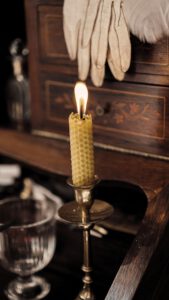Affiliate Disclosure
Some of the links on this page may be affiliate links. As an Amazon Associate, I earn from qualifying sales from these links. If you make a purchase or sign up for a membership through these links, I will receive a small commission. This will not cause any additional costs for you. This income helps us to run this website and especially the blog for you.
We own too many things
“Decluttering” has been a trend topic for several years now.
At the same time, more and more DIY channels were emerging that deal with decoration for the home, which has fueled the Covid pandemic. Interior design is a passion shared by many. I am one of them. Searching flea markets and online ads for unique pieces for the home has become a real hobby for some. What years ago, was more of a necessity for me to save money, also became a passion for me.
But whenever something is trending, prices go up. In the past, cheap, used things have become correspondingly high-priced.
On the one hand, I think it’s good that things are no longer simply thrown away or that people first try to buy the desired part second-hand. But that being said, most people still mainly buy their home furnishings from large stores or online. What I have noticed for years in my environment is that everyday objects, such as cleaning accessories, are bought completely without regard to their appearance. Purely functional parts are purchased. Mostly made of plastic. Because they are so ugly, you need more storage space to hide them for most of the time.
Or if you don’t, it causes visual clutter and therefore unrest and clutter. For more storage space, however, you need more space and have correspondingly higher expenses. Which leads to the fact that we first have to earn more or regularly have higher expenses because we need a correspondingly larger living space, just to somehow store all the stuff that we accumulate over time in a reasonably tidy way.
How a move plunged me into chaos
A few years ago, before all the inflation chaos and when our money was worth a little more, I had a nice, large 3-room apartment. I had enough storage space and how everyday objects looked was not necessarily super important to me. Because I’ve always tried to be extra tidy and put everything in the storage space provided. But then I became a mother and gave up my biomedical studies.
What was originally supposed to have been a new start became a kind of false start and I had to completely rethink my life situation. It was clear at the time that I had to reduce my costs, and I had to do so significantly. And I had to try to buy myself more time. The only way to achieve this was to move to an apartment that cost only half as much and which significantly shortened my travel times due to its location.
The downside was that this apartment was only half the size of the old apartment before. And although I had subjectively had the feeling that I had been very neat and organized and didn’t have that much stuff, I sank into chaos in the new apartment.
Mastering the chaos
In the first few months, it was hardly possible to move around in the much smaller rooms of the new apartment. Everything was filled with furniture and boxes. It was really pretty bad. That was in mid-2019. So before the Covid pandemic. But about half a year later, the pandemic came and with it the home office abruptly. I was not only at home to sleep, but all day and that too with a toddler. So I had to work full-time, study for a vocational qualification and somehow take care of my child, all at the same time. My living situation felt like a trap.
My mental health suffered immensely from the stress and also from the many things and furniture. I felt crushed, couldn’t breathe, couldn’t sleep well, couldn’t concentrate. It couldn’t stay that way. So I started sorting out. And do it right. At that time I established the rule for myself: For every part that comes along, 2 parts have to go. I have maintained this to this day.
Multi-functional parts
It was also then that I realized that I couldn’t have a table for paperwork (a secretary at the time), one for dining (a very large, round dining table), a console table (because it looked nice and had room for decoration), a sewing machine table (with a built-in sewing machine and in fact I even had 2!! of it), a children’s table, a coffee table, a side table and a huge cutting table (for cutting fabrics), would be able to keep. And that was just the tables! And all on less than 40 square meters. So I started selling all the furniture that wasn’t absolutely necessary or replacing it with pieces that could be better used for multifunctional use.
Instead of a children’s table and a coffee table, I found a used side table that had the right dimensions to be both. I bought two small stools and since then the “children’s table” has also been the coffee table in our living room. He was then given additional roles and can even be pushed aside by the kids themselves to make room for gymnastics and play.
A table for all occasions
For those of you who have just wondered why you actually need an extra cutting table, here is the explanation: Most of the fabric panels are between 140-160cm wide. In the vast majority of cases, panels of fabric are cut to size in double laying. In other words, the half-folded fabric is then 70-80cm wide in most cases. In order to be able to spread the fabric comfortably, smoothly, to transfer and cut out the patterns, you need a correspondingly large area. In addition, it is more pleasant if it is at standing height, as you cannot work in a sitting position. So my cutting table was higher than a normal table and 120cm wide x 90cm deep. Normal desks are usually only 60cm deep.
So the solution could only be to sell all other tables and buy a multifunctional table. But as just mentioned, modern desks are too small. I have therefore been looking for an antique desk for months. These very often have significantly larger dimensions. But there was a problem. All these tables were massive and in one piece. No one I liked could be disassembled. My apartment had a tiny hallway and you would have had to go around several corners. It was simply impossible to maneuver such a large piece of furniture through the hallway around three corners and through three doors to my study.
I guess I didn’t have a choice. I had to build a suitable table myself. Inevitably, it didn’t get so high that I could work on it comfortably while standing, but it has the right dimensions that I can cut fabrics on it properly. And because it has an L-shape, I can easily put my laptop or sewing machine aside when I need the large area. It also offers a lot of storage space.
Functional decoration
When it comes to decoration, I’m more of a minimalist. I would have neither the time nor the desire to clean countless objects from dust on a regular basis. But of course, no decoration at all is not a solution, I think. However, I take great care that I don’t have any useless objects standing around. But this is absolutely not about “right” or “wrong”.
Everyone can and should find the preferred balance for themselves when it comes to decoration. And surround yourself with the objects that bring you joy. Personally, I have found that it is much easier if you try to acquire all everyday objects in such a way that they already result in beautiful decorations on their own.
Why my cleaning clothes are hanging on my wall
Some of the things I used to hide in cupboards actually hang on a wall in my kitchen these days. And I think it’s really, really beautiful. There hangs, for example, a notch shovel made of metal, a broom made of wood, with bristles made of coconut fibers and, among other things, an antique brass watering can. I use all these parts regularly. They are absolutely useful commodities.
Today, I can no longer imagine buying such or similar parts made of colorful plastic. Have you ever noticed that in the past, and by that I mean in the days of our grandparents and great-grandparents, objects were mostly beautiful?
And above all, they were almost indestructible and lasted for decades. If something did break, it was repaired. Why did we, as a society, eventually find that it was a good idea to make things we use every day as ugly (in my opinion), harmful to the environment (fact), harmful to health (fact) and fragile (in most cases fact) as possible?
I don’t buy (almost) any decorations anymore
For some time now, I have established this rule for myself that I don’t buy decorations that are really just decoration and nothing more. Also, I try to find pieces that are really beautiful and that I really need. And which have a benefit and a function at the same time. Not only do you have a lot less things to worry about, but you also get more pleasure from using these everyday items. So I think watering flowers is much more fun with an antique brass watering can than it would be with a simple plastic jug.
Conclusion
I think we can only benefit if we surround ourselves with things that we have carefully chosen. Of course, particularly beautiful and sustainable pieces may cost a little more. But on the other hand, you probably enjoy them more and they also last longer, apart from the fact that at best you even protect the environment. What do everyday objects have to be like for you? Just useful or also aesthetically pleasing? Do you love a lot of decoration or do you prefer it minimalist? Feel free to let me know in the comments.
I wish you a relaxing weekend.
All the love
Christina
“Compared to the ability to organize the work of a single day in a meaningful way, everything else in life is child’s play.”
Johann Wolfgang von Goethe
Share this post:

We’re excited
to share our news with you!
Would you like to receive information about our latest articles and our latest products directly in your mailbox?
Sign up for our newsletter!
We’d love to keep you in the loop.
About the author

Christina Ernst is founder and CEO of Linen & Quince. She is also a designer, author and real estate expert. She shares her experiences and knowledge not only on our Linen & Quince blog, but also on her personal blog, christinaernst.net , where she writes about financial knowledge, starting a business, real estate knowledge and personal development. She loves interior design, art, antiques, as well as elegant, sustainable and high-quality fashion.



